Remote Monitoring & Quality Management
A Technology Guide
This guide looks at the evolution of remote clinical trial monitoring from a technology perspective. Our goal is to help accelerate the adoption of remote monitoring by providing clinical operations professionals with a concise guide to understanding the technology options available to support remote monitoring.
We review the basics of clinical monitoring, the tools available and in use today, and the essential processes that a remote monitoring system must support. We conclude with a suggested set of steps that an organization can take to adopt remote monitoring technologies quickly.
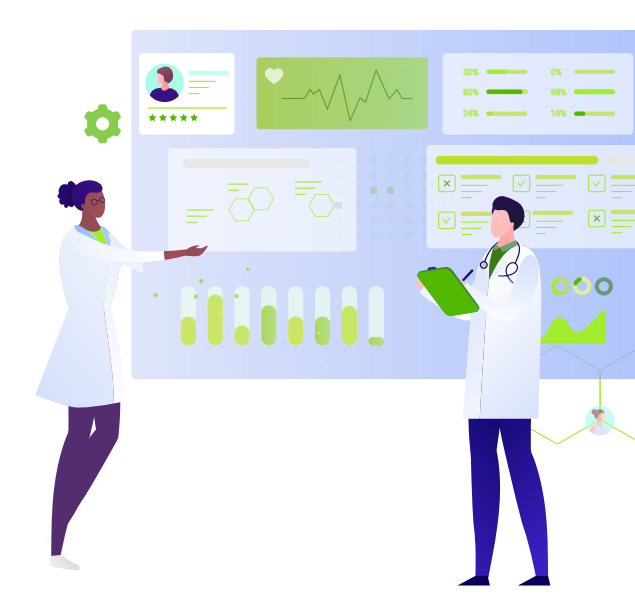
The requirement to monitor clinical trials is typically performed by a study monitor through in-person visits to clinical sites. This long-established practice of traveling to sites has been both effective in conducting oversight and expected by the regulatory authorities. It is also extraordinarily costly for sponsors and CROs in terms of time spent and travel costs.
In the last few years, there has been some exploration and experimentation with an alternative approach to study monitoring called remote site monitoring. Remote site monitoring enables the monitor to conduct oversight activities remotely without visiting the study sites. While adoption of this approach has been slow, travel restrictions brought on by COVID-19 have forced the clinical trial industry to identify and put in place an alternative to on-site visits, making the need for remote monitoring techniques urgent.
A discussion of remote site monitoring and its benefits has to start with a definition of clinical trial monitoring overall.
What is Clinical Trial Monitoring?
Organizations and companies that sponsor clinical trials are responsible for ensuring they are conducted in a safe, effective, and accurate way. The clinical monitoring function is a central process in fulfilling that obligation.
The unified standard used to ensure the acceptance of clinical data by regulatory authorities in the United States, EU (European Union), and Japan, as well as Australia, Canada, the Nordic countries and the World Health Organization (WHO) is the ICH-GCP – International Conference on Harmonisation of Technical Requirements for Registration of Pharmaceuticals for Human Use (ICH) of GCP (Good clinical practice) guidelines. Learn more about this standard at ICH GCP
According to ICH-GCP, the purposes of trial monitoring are to verify that:
- The rights and well-being of human subjects are protected.
- The reported trial data are accurate, complete, and verifiable from source documents.
- The conduct of the trial is in compliance with the currently approved protocol/amendment(s), with GCP, and with the applicable regulatory requirement(s).
Who does the monitoring, and what do they actually do?
Monitors are Clinical Research Associates (CRA), appointed by the Sponsor, or the Contract Research Organization (CRO) acting on behalf of the Sponsor. A CRA has the right knowledge, education, and experience to perform clinical trial monitoring activities.
As to what a monitor does, traditionally, they travel. A lot! And that’s because the monitoring function has been defined by the FDA as an activity that includes visits to the clinical sites. The FDA’s stance on this has changed considerably, but the established practice of monitors traveling to sites for periodic in-person visits is well established.
A monitor performs the following activities:
- Ensures the investigator and staff are qualified
- Confirms all required documentation is collected and in order
- Checks all source data (records) are collected and transcribed onto case report forms accurately (Source Data Verification)
- Ensures the protocol is being followed
- Ensures that patient safety and rights are being protected, especially that all patients have consented to participate and were recruited in an ethical manner
- Monitors the supply of medications used in the trial
- Reviews and gains approval for changes and deviations from the study plan
This list is far from complete but provides a sense of the scope of the monitor role and the diversity of activities.
What is Remote Monitoring?
The coronavirus pandemic put restrictions on travel, making traditional monitoring and inspections impossible. With no way to conduct monitoring activities, or connect monitors, inspectors, and clinical sites, the clinical trial ecosystem has broken down and many trials came to a halt. Remote monitoring is the answer to this challenge.
Remote monitoring of clinical trial sites involves the same activities as on-site monitoring – only virtually. There are a few benefits to remote site monitoring including:
- Quicker turnaround of reviews because the monitor doesn’t need to travel to different sites.
- Monitors can review more sites in a given time period, again because they are spending a lot of time traveling between sites.
- Faster sharing of data from the ISF (Investigator Site File) to the TMF (trial master file) through electronic sharing.
- A decrease in travel costs – which can amount to millions – for sponsors and CROs.
To be successful with remote site monitoring, the right tools and technologies are necessary to enable a monitor to complete their activities securely and in compliance with standards.
The Evolving Regulatory Perspective on Remote Monitoring
Life sciences companies almost always take a cautious and conservative approach to compliance with regulatory requirements. The costs of a mistake are enormous, and the Regulatory Authorities typically offer “guidance,” not hard and fast rules, which encourages sponsors and CROs to be far inside the boundaries. If there is a sense that the FDA “prefers” one approach to another in any area, companies will tend to take the preferred method.
The idea that a monitor should go to the site, look in person at the source documents, see the ink on signed consent forms, interview participants across a table and see the processes in action for themselves is very deeply entrenched. In fact, in-person monitoring is documented right in ICH and FDA guidance documents.
Although remote monitoring and quality processes have been slow to take hold, they have been the subject of many panels and presentations at conferences. The COVID-19 crisis and its restrictions on travel have acted as an enormous catalyst to change. Clinical trials include life and death situations, and stopping all clinical trials is simply unacceptable.
In the United States, the FDA has responded directly:
“If planned on-site monitoring visits are no longer possible, sponsors should consider optimizing the use of central and remote monitoring programs to maintain oversight of clinical sites.”
This quote is extracted directly from FDA guidance issued in March 2020 (and updated in June), showing the FDA recognizes the need for flexibility. Even before the COVID-19 crisis, the FDA had been urging sponsors and CROs to take a risk-based approach to monitoring and quality management, emphasizing their support for statistical sampling versus 100% source data validation.
The FDA is piloting remote processes themselves. They have initiated a remote auditing process to be used voluntarily by device manufacturers. As documented in a press story, “The new FDA program is intended to implement a novel approach to the auditing process allowing (sic) to perform the audit in the off-site form. According to the position of the Agency, the new approach would also engage both auditors and organizations subject to the audit to use actively the new technologies…”
The coronavirus crisis has pushed remote monitoring to the forefront. Although in-person site visits will likely restart when things have settled, it will be impossible to ignore the benefits of remote monitoring completely, in particular, the cost savings.
Audits involve specific activities designed to test and confirm that the quality plan is being followed and that the study is following quality practices. The audit is the clearest manifestation of the quality process during a trial and results in a formal audit report with findings.
Ideally, a technology solution designed for remote monitoring would be extensible to remote quality management as well. The need is just as acute, and the functionality required is a natural extension, basically to support the documentation of the audit plan, activities during the audit, audit findings and follow-on actions, and lastly, the automated creation of the audit report inclusive of the findings.
The question is, “how” is remote monitoring being put into practice? What tools and technologies are being used? The current approaches seem to fall into three groups.
File Share and Sync Solutions
The first group is using a class of systems known as “file share and sync” applications, such as Box and Dropbox. With this approach, site administrators are asked to load documents into a cloud-based repository, where the monitor can also access them. Access can be limited to the site administrators and the monitors. This is a simple approach that lets a monitor see documents.
While this meets the basic functional need to share and see documents, the use of file-sharing tools is inappropriate as a remote monitoring solution. Loading study documents into a repository that may be neither CFR 21 Part 11 nor HIPAA compliant is an unacceptable practice. There is also the question of how a record of the custody and authenticity of the documents is maintained.
File sharing only addresses a portion of the monitoring function; the need to manage monitoring processes such as assigning tasks needs to be a part of any solution.
Document Management Solutions
A second approach is with a system that is purpose-designed for sharing documents in a life sciences scenario. These solutions are usually fully compliant with regulatory requirements. If they are cloud-based, they can be easily accessible to both the site team and the monitor while controlling access.
While these repositories do provide a way for the site and the monitor to share documents, they are not purpose-built for the monitoring function. Similar to file sync and share solutions, they lack support for other monitoring processes beyond basic document review. So, this approach is useful for a key part of the monitoring process, but not for all aspects of it.
Purpose-Built Remote Monitoring Solutions
The third approach is with purpose-built systems that directly address the monitoring and quality management function, including but not limited to the document review process. These solutions include the ability not just to see documents but to share comments, assign tasks to the site administrators, and for the site staff to respond to the monitor.
Some solutions also include capabilities designed explicitly to capture monitoring notes and recorded materials, such as video or audio interviews and functionality for the quality function such as audit management.

User Stories and Requirements for a Remote Monitoring Solution
Designers and developers of software solutions often use “User Stories” to document the essential capabilities of an application. User stories are presented in the format of “As a <blank> user, I need to be able to <blank>.”
User stories are beneficial because they provide a crystal clear summary of the core functionality of a system. A collection of user stories presents the required capabilities from the perspective of the different personas who will use and manage the system, such as end-users, system administrators, and process owners.
Let’s examine the user stories that reflect the requirements for a Remote Monitoring and Quality Management application.
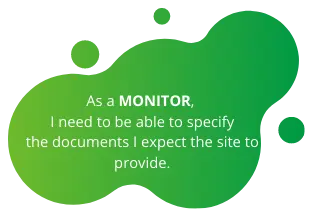
While the Trial Master File reference model (reference) specifies the standard contents of the TMF and the subsidiary ISF (investigator Site File), every clinical trial has its own additions and changes to the set of expected documents.
The monitor or quality manager needs the ability to communicate to the site the specific set of documents and files that the site is responsible for providing.
This user story also implies that site administrators should have the ability to load multiple documents at a time and, optionally, put documents through a review and approval process.
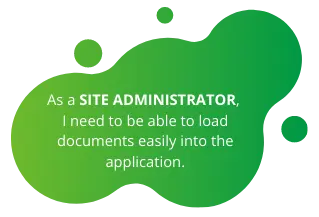
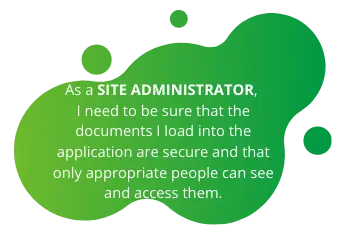
This user story addresses a central concern of sites, which is that they must be absolutely certain that putting documents into a system for monitoring and quality management is legal, compliant, and safe.
The application, therefore, must allow only credentialed users access to see the content, and the system must be compliant with 21 CFR Part 11 and HIPAA requirements.
The system should also prevent users from printing or downloading items depending on the state of the item and the person’s role.
Monitors need the ability to access the collection of site documents through a secure access point. When a monitor is on-site, they typically document issues with post-it-notes and similar mechanisms.
The remote monitoring application must replicate this method of documenting issues. The monitor must be able to attach a comment to a document along with a related call to action for the site team.
Also, notification that an issue has been identified and requires attention must be sent.
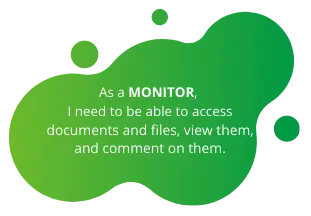
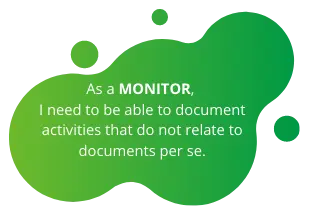
Monitors do more than review documents. They also make observations about processes and practices, and they may interview specific site team members. For this reason, a monitor needs a place to collect other information, for example, additional notes that they want to share with the site team, or recordings and notes from interviews.
The monitor should also have the ability to generate a notification and task for the site team for each item if they desire.
Just as they would if a monitor left a note on a document, site administrators need to be notified that there is an issue with a document that requires attention. For example, they could be notified via an email message, where they can see what the issue is.
Then they need to address the issue, for example, by replacing or editing the item.
Finally, they need to be able to communicate back to the monitor that they have addressed the issue.
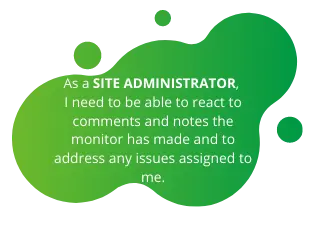
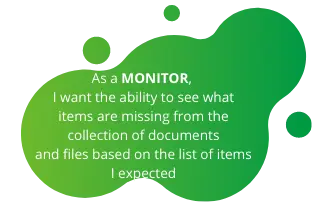
A “What’s Missing” capability makes the monitor’s job a lot easier. Rather than deduce the list of missing items after a manual review, the system can provide a list indicating the state or stage of each item.
For example, the list would show items that are missing, have been flagged, and are final and have been reviewed.
When a site creates and loads items into the system, they are building or copying their binder files.
Ultimately, a subset of those documents ends up in the Trial Master File (TMF), so it would be great to be able to move those items from one space to another easily.
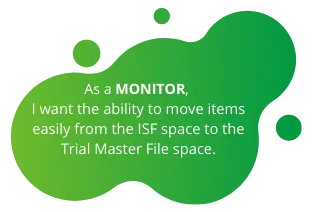
Technical and System Requirements
Beyond the User Stories, every system has a number of other requirements, including security requirements, performance requirements, and scalability needs. Successful remote site monitoring and quality management requires three critical, overarching system requirements.
Cloud-based
The Remote Monitoring Application must be cloud-based. The solution must be available to monitors and sites from different locations. A remote monitoring solution hosted in the cloud provides high security, improves performance and ensures a scalable solution. While one could argue that a VPN or other network access scheme could work, in practice, those models would impede adoption and reduce the ease of use.
Compliant with Regulations
The Remote Monitoring Solution must be compliant with regulatory requirements for the jurisdiction(s) in which it will be used, for example, with 21 CFR Part 11 and HIPAA in the United States. This requirement comprises some specific capabilities, such as full audit trails and support for eSignatures.
Integration Requirements
A remote monitoring technology solution that meets the needs described in the user stories would take its place within the whole ecosystem of clinical trial technologies and processes. For that reason, the ability to connect to other systems is critical.
For example, integration between the remote monitoring solution and the Clinical Trial Management System (CTMS) would be valuable, as would integration with any data collection system (EDC).
Fortunately, most modern, cloud-based applications include a fully supported application programming interface (API) or set of APIs to enable the integration of other systems. A fully documented REST API should be included in any list of requirements for a remote monitoring solution.
Defining your requirements starts with your user stories. Once you have identified all the user stories for your situation, you can outline a set of requirements for your remote monitoring solution. With your requirements defined, you can look at potential solutions, identifying one or more that meet most, or all your needs.
What happens when you find decide on a solution? How do can you be sure it’s the right choice before you buy?
Start with a Pilot
Piloting a remote monitoring application with a limited set of sites is a way to reduce the risks that accompany implementing a remote monitoring solution.
However, it’s important to understand that a remote monitoring pilot is more complicated than a pilot may be for other types of solutions due to the nature of clinical trials, regulatory requirements, and the need for documentation.
Software vendors often provide limited pilots that give potential customers access to the solution with little to no support during the pilot period. With a remote monitoring trial, you should demand the vendor support you during the pilot to ensure you fully understand what’s available and how it will work for your requirements.
A remote monitoring pilot should provide the following:
- A defined list of activities from the user stories to test during the pilot. The list should include one or more complex activities, along with several of the most common activities. The number of activities you include depends on the length of the pilot period, so make sure you choose the best activities to test.
- The pilot must include documenting the exact approach to be used for each activity, including any differences in the documentation or processes required for each site in the pilot.
- A clear plan of action for introducing the solution to all participants in the pilot, including the support and training offered during the pilot.
- Regular check-ins as the solution is implemented to ensure monitors and pilot sites do not get stuck with insurmountable obstacles.
- An escalation process that monitors and sites can use if they require additional support or run into problems.
Choosing the Study and the Sites
For an initial project or pilot, perhaps the most important factor that will determine success is choosing the study or the sites involved carefully. Any change in a well-understood but complex process is challenging, but this goes beyond that.
Implementing new technologies for remote monitoring directly affects how site administrators do their job, and as a group, site administrators are very busy people. Asking them to complete new steps and to use an unfamiliar system is, as they say, a “big ask.”
The key is to select a study and a set of sites that are not excessively challenging in other ways. If the relationships between the sponsor, CRO, monitor, and site are already in place with a history of success, the ability — and willingness — to drive changes in processes and systems successfully will be much higher.
Adopting Piloted Technologies as a Standard
When you near the end of the pilot, you may decide the solution works exactly as you need and want to continue using it beyond the pilot, or you may choose to wait until the pilot is complete before completing your review.
In either case, a formal review of the cost, efficacy, and benefits of the technology being adopted should be completed, confirming the tool and approach piloted will enable a successful remote monitoring processes. Lessons learned should result in new, updated processes documented in monitoring plans and SOPS.
By making the things that have worked part of the new standard operating procedures, remote methods for executing monitoring processes will become part of the new normal. And by discarding or adjusting ideas and tools that do not pay off in practice, the costs associated with them — in money, time and frustration — can be avoided.
Building a Fully Virtual Clinical Trial Environment
The reality of decentralized trials is that no one technology platform or solution will encompass all of a remote or virtual clinical trial’s processes. The move to the remote execution of trials will involve a set of solutions, each with increasing abilities to be used in a remote model; remote site monitoring is only the start.
To help you understand all the various technologies you will need beyond a remote monitoring solution, ask yourself the following questions:
- How and where will site binder files (Investigator Site Files) be stored and accessed by the monitor?
- How will source documents and patient records be accessed?
- How will interviews be conducted and documented?
- How will patient data be collected and shared?
Technologies such as EDC, CTMS, TMF, and others will need to evolve to support fully virtual and decentralized clinical trials and many are in the process of doing so.
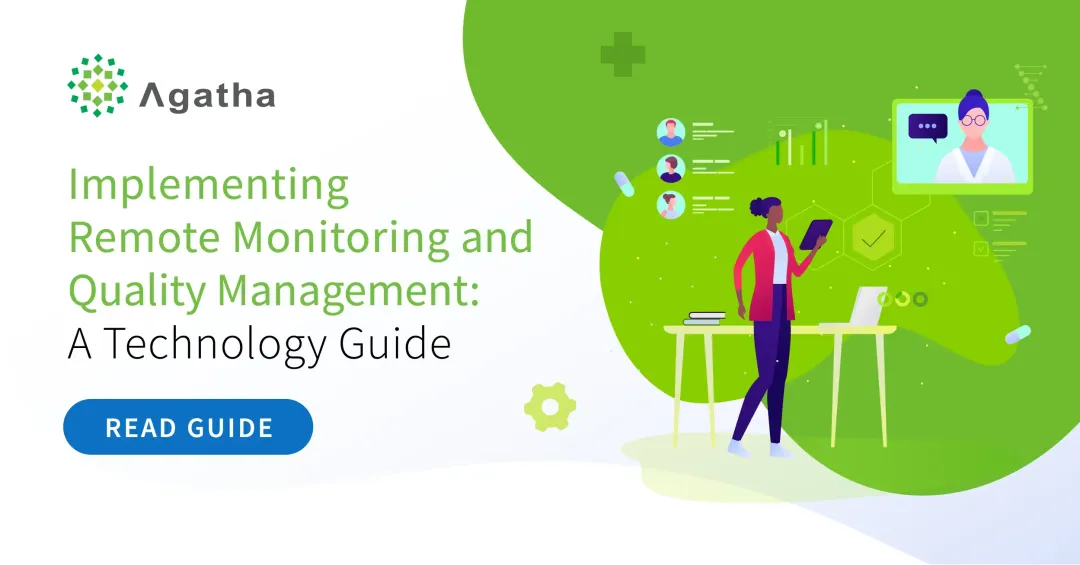
Download the Remote Monitoring ebook
Get your concise guide to understanding the technology tools and options available to support remote monitoring for clinical trial Sites.
Here’s what we do know:
1. In addition to basic communications technologies — telephone, videoconferencing, and email — file sync and sharing technologies are available for sharing documents. However, these technologies, by themselves, do not address the full range of requirements for a more comprehensive monitoring process and raise questions of compliance with regulatory requirements such as 21 CFR Part 11 and HIPAA.
2. Study monitoring includes more than reviewing essential documents. A comprehensive remote monitoring solution has to address the need to see, review, and track essential ISF and source documents, but also the need to automate and manage monitoring processes. These processes include the ability to add comments to documents, create tasks, and track the completion of those tasks. And of course, the right solution has to address the full range of regulatory requirements.
3. Beyond functional capabilities, a technology solution for remote monitoring must address the realities of the clinical site user environment. Within a clinic, patients come first, and staff members are pressed for time. So ease of use is paramount.
For organizations seeking to move forward and implement remote monitoring, some best practices have emerged from early adopters:
- Choose a less-complex study and familiar sites for an initial pilot.
- Consider a hybrid approach, using remote technologies for many aspects of the monitoring process while leaving some activities for an in-person visit.
- Think beyond the binder: Monitoring is not limited to document reviews; remote monitoring must address monitoring processes, not just document sharing.
- Ensure the solution is compliant with regulatory requirements for document management and privacy considerations.
- Consider a single solution that can be used for both monitoring activities and full audit management.
- Meet and interview “those who have gone before” to learn from their challenges and successes.
Interested in seeing how Agatha’s applications can help you improve your clinical and quality processes? Take it for a test drive.